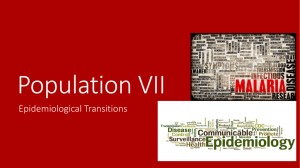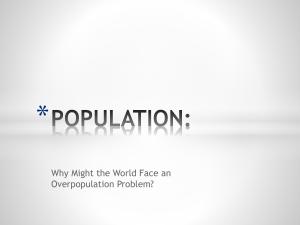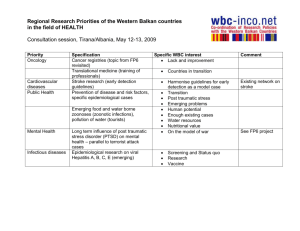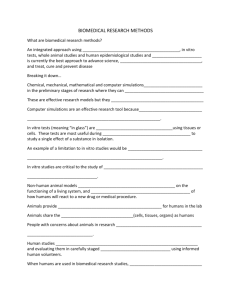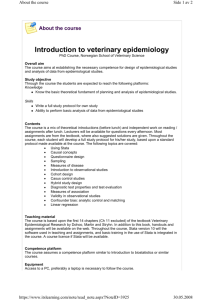File
advertisement
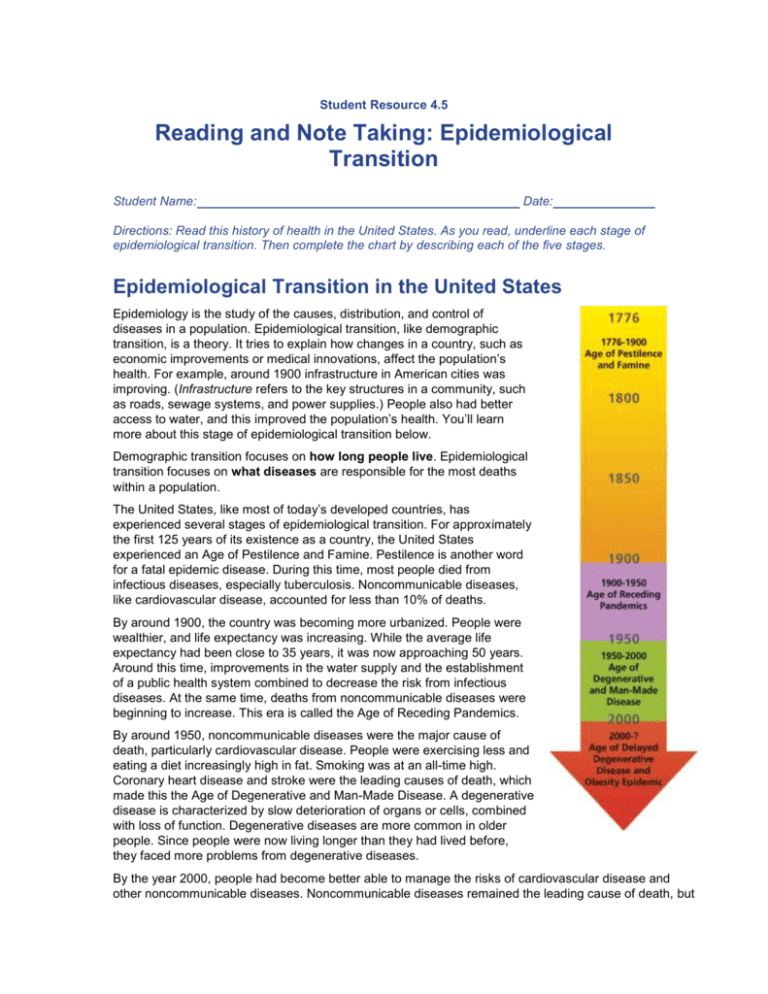
Student Resource 4.5 Reading and Note Taking: Epidemiological Transition Student Name: Date: Directions: Read this history of health in the United States. As you read, underline each stage of epidemiological transition. Then complete the chart by describing each of the five stages. Epidemiological Transition in the United States Epidemiology is the study of the causes, distribution, and control of diseases in a population. Epidemiological transition, like demographic transition, is a theory. It tries to explain how changes in a country, such as economic improvements or medical innovations, affect the population’s health. For example, around 1900 infrastructure in American cities was improving. (Infrastructure refers to the key structures in a community, such as roads, sewage systems, and power supplies.) People also had better access to water, and this improved the population’s health. You’ll learn more about this stage of epidemiological transition below. Demographic transition focuses on how long people live. Epidemiological transition focuses on what diseases are responsible for the most deaths within a population. The United States, like most of today’s developed countries, has experienced several stages of epidemiological transition. For approximately the first 125 years of its existence as a country, the United States experienced an Age of Pestilence and Famine. Pestilence is another word for a fatal epidemic disease. During this time, most people died from infectious diseases, especially tuberculosis. Noncommunicable diseases, like cardiovascular disease, accounted for less than 10% of deaths. By around 1900, the country was becoming more urbanized. People were wealthier, and life expectancy was increasing. While the average life expectancy had been close to 35 years, it was now approaching 50 years. Around this time, improvements in the water supply and the establishment of a public health system combined to decrease the risk from infectious diseases. At the same time, deaths from noncommunicable diseases were beginning to increase. This era is called the Age of Receding Pandemics. By around 1950, noncommunicable diseases were the major cause of death, particularly cardiovascular disease. People were exercising less and eating a diet increasingly high in fat. Smoking was at an all-time high. Coronary heart disease and stroke were the leading causes of death, which made this the Age of Degenerative and Man-Made Disease. A degenerative disease is characterized by slow deterioration of organs or cells, combined with loss of function. Degenerative diseases are more common in older people. Since people were now living longer than they had lived before, they faced more problems from degenerative diseases. By the year 2000, people had become better able to manage the risks of cardiovascular disease and other noncommunicable diseases. Noncommunicable diseases remained the leading cause of death, but people were more aware of how to reduce their risks by not smoking and by watching their diet. People were able to stay healthier for longer. This era is called the Age of Delayed Degenerative Disease. However, there are signs that the United States and similar countries may be entering a new fifth phase, characterized by rising obesity rates and a decrease in physical activity. This era could be called the Age of Obesity Epidemic. In the last 40 years, the percentage of Americans who are considered overweight or obese has grown consistently. This could change the trend of delayed degenerative disease, since being overweight or obese raises the risks for heart disease, diabetes, some types of cancer, and many other health problems. Fill in the characteristics of the five stages of epidemiological transition. Stage of Epidemiological Transition Characteristics Age of Pestilence and Famine Most people died from infectious diseases. Age of Receding Pandemics Age of Degenerative and Man-Made Diseases Age of Delayed Degenerative Disease Age of Obesity Epidemic Stage of Epidemiological Transition Characteristics
